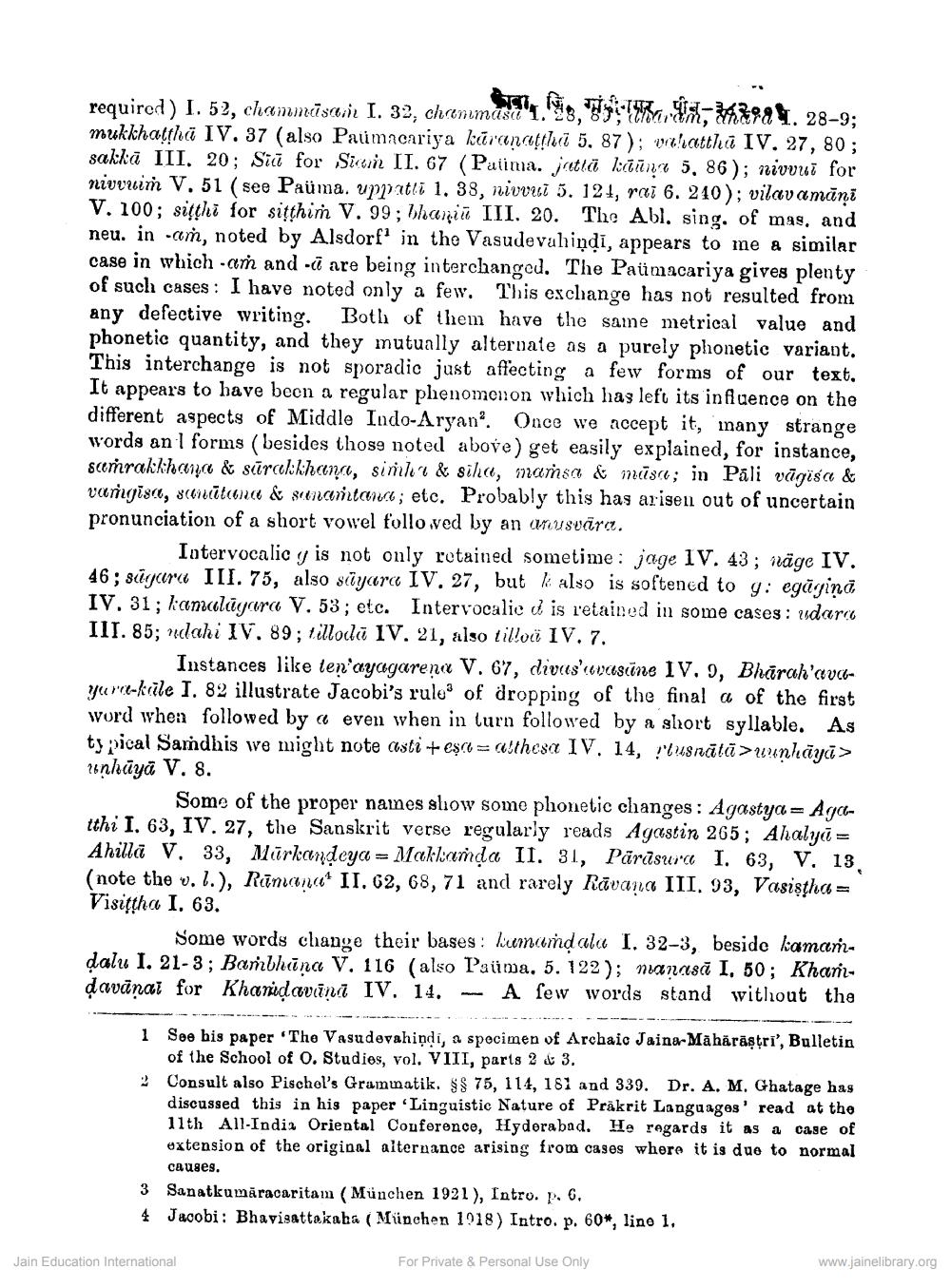________________
Maram,
required) I. 52, chammasan I. 32, chammas, 28-9; mukkhatha IV. 37 (also Paumnenriya karapathi 5. 87): vahattha IV. 27, 80; sakka III. 20; Sia for Stan II. 67 (Patima. jatta kāāya 5, 86); nivou for niveuih V. 51 (see Pauma. uppatti 1, 38, nivvui 5. 121, rai 6. 240); vilavamānī V. 100; sitthi for sitthim V. 99; bhaniu III. 20. The Abl. sing. of mas, and neu. in am, noted by Alsdorf' in the Vasudevahindi, appears to me a similar case in which amh and - are being interchanged. The Paumacariya gives plenty of such cases: I have noted only a few. This exchange has not resulted from any defective writing. Both of them have the same metrical value and phonetic quantity, and they mutually alternate as a purely phonetic variant. This interchange is not sporadic just affecting a few forms of our text. It appears to have been a regular phenomenon which has left its influence on the different aspects of Middle Indo-Aryan. Once we accept it, many strange words anl forms (besides those noted above) get easily explained, for instance, samrakkhana & surakkhana, simh & sila, mamsa & masa; in Pali vägisa & varigisa, sunatana & munamtana; etc. Probably this has arisen out of uncertain pronunciation of a short vowel followed by an aruseära.
Intervocalicy is not only retained sometime: jage IV. 43; näge IV. 46; sagara III. 75, also sayara IV. 27, but also is softened to y: egagiņā IV. 31; kamalayara V. 53; etc. Intervocalie d is retained in some cases: udara III. 85; dahi IV. 89; tilloda IV. 21, also tillo IV. 7.
Instances like ten'ayagarena V. 67, divas'evasine IV. 9, Bharah'avayur-kale I. 82 illustrate Jacobi's rule of dropping of the final a of the first word when followed by a even when in turn followed by a short syllable. As typical Samdhis we might note asti + esa atthesa IV. 14, plusnātā>uuṇhāyā> unhāyā V. 8.
Some of the proper names show some phonetic changes: Agastya Aga tthi I. 63, IV. 27, the Sanskrit verse regularly reads Agastin 265; AhalyaAhilla V. 33, Märkandeya Makkamda II. 31, Parasura I. 63, V. 13, (note the v. l.), Ramana II. 62, 68, 71 and rarely Ravana III. 93, Vasistha= Visittha I. 63.
Some words change their bases: kumandalu I. 32-3, beside kamamdalu I. 21-3; Bambhana V. 116 (also Pauma. 5. 122); manasa I. 50; Khamdavaṇal for Khaniḍavana IV. 14. A few words stand without the
1 See his paper The Vasudevahindi, a specimen of Archale Jaina-Maharastrı', Bulletin of the School of O. Studies, vol. VIII, parts 2 & 3.
2 Consult also Pischel's Grammatik. §§ 75, 114, 181 and 339. Dr. A. M. Ghatage has discussed this in his paper 'Linguistic Nature of Prakrit Languages' read at the 11th All-India Oriental Conference, Hyderabad. He regards it as a case of extension of the original alternance arising from cases where it is due to normal
causes.
3 Sanatkumaracaritam (München 1921), Intro. p. 6.
4 Jacobi: Bhavisattakaha (München 1918) Intro. p. 60*, line 1.
For Private & Personal Use Only
Jain Education International
www.jainelibrary.org




